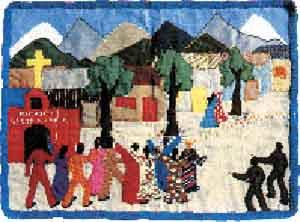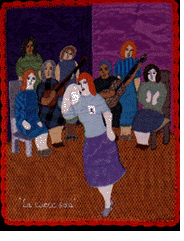Threads of Hope: desparachos (disappeared) and arpilleres (tapestries)
 It happens on occasion in my work that a student asks me: is it possible to create new theatre forms?
It happens on occasion in my work that a student asks me: is it possible to create new theatre forms?I usually respond, rather dryly, no. Then I make a comparison of visual art and theatre. Yes, we have often new styles: seemingly every other new kid on the block has his gimmick, his particular way, or style. But look at the social form of painting: galleries are dead in the sense of who today can think of creating for the tastes and needs of the rich, the famous or some bank? Who goes to those galleries, or to museums, for that matter. For me, museums are as bad as church. (Obviously certain tourist and academic reasons do exist for going).

But form is another matter, related to function. Look at the origin of Hip Hop, as my friend MC Baba puts it: it was about a community creating a space (a form) where there was no space.
Or speaking on theatre: I would much rather see a show put up by a group of retirees in a social centre speaking about their lives than go to an expensive theatre and sit in the dark and watch the avantguardia "dallying with forms".
Nothing compares to the pain of the mother.
So this brings me to this wonderful and sad film, Threads of Hope by Andrew Johnson, about the Chilean mothers of the desparachos. We see how the cries of the souls of these mothers transformed a tradition of tapestry weaving into a political force that eventually brought the world’s attention to the brutal military regime of Pinochet. Here we see the healing, transformative power of art at the service of politics. But more than politics: these are real acts, Promethean acts of courage and rebellion, death defying gestures, akin to that lone individual who stood up to the tanks in Tinaman Square. The police would actually seek out these arpilleres and their makers. They had to be smuggled out of the country to be put on exhibition.
Here we see the healing, transformative power of art at the service of politics. But more than politics: these are real acts, Promethean acts of courage and rebellion, death defying gestures, akin to that lone individual who stood up to the tanks in Tinaman Square. The police would actually seek out these arpilleres and their makers. They had to be smuggled out of the country to be put on exhibition.
My son is a piece of my heart and without that piece of heart the machine doesn’t work well.
In the naiveté of the visual forms, in the “poor” aspect of the production, in the sincerity of expression, in these desperate outcries, we find that all too evasive and perfect union of form and content; of political and artistic, of daily life and rebellion. In the fragmentation of their souls, in their actual physical loss of their children (an extension of their very bodies, their flesh) there is an attempt of reconstruction. In the actual working of the material, as they pieced together bits of found cloth, they were able to weave together new life. From pain and grief, through artistic creation, they found courage and strength. And in the consequent forming of new communities and of a sense solidarity with other grieving mothers they created a political movement.
We see also other art forms were transformed by the mothers of the desparachos, in music and dance; and in their travels and networking these new forms were exported to other countries in need, South Africa and Argentina, for example.
Yet for many there is still a search for closure, that only when the truths be told will their suffering be assuaged.
 (a tapestry from Afghanistan)
(a tapestry from Afghanistan)
I ask and I’ll never tire searching and asking: what has happened to him? Someday they’ll come back. A home is waiting, a beating heart is always asking: will they come home someday?
 You can see this wonderful film for free online at the great and resource rich site: http://www.arcoiris.tv/
You can see this wonderful film for free online at the great and resource rich site: http://www.arcoiris.tv/
Look for the "Ricerca" window and type in "Threads of Hope".
Or download/open directly to the film: Real Player; Media Player.



1 Comments:
Moving along. This blog is happening. TW
Post a Comment
<< Home